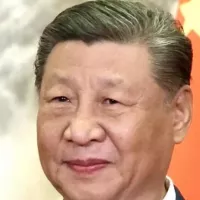China, officially the People's Republic of China (PRC), is an East Asian country with a population exceeding 1.4 billion, making it the second-most populous globally. It shares land borders with fourteen countries and is the third-largest country by area at 9.6 million square kilometers. China is divided into 33 province-level divisions, including provinces, autonomous regions, municipalities, and special administrative regions. Beijing serves as the capital, while Shanghai is the most populous city and a major financial center.
1901: Boxer Rebellion weakens the Qing dynasty
In 1901, the anti-foreign Boxer Rebellion further weakened the Qing dynasty.
1905: Release of the first Chinese film, Dingjun Mountain
The first Chinese film, Dingjun Mountain, was released in 1905.
1911: Xinhai Revolution
In 1911, the Xinhai Revolution ended the Qing dynasty.
January 1912: Establishment of the Republic of China
In January 1912, the Republic of China (ROC) was established, and Sun Yat-sen was proclaimed provisional president.
March 1912: Yuan Shikai becomes president
In March 1912, Yuan Shikai was given the presidency of the Republic of China.
1912: Abdication of the Last Emperor
In 1912, Puyi, the last Emperor, abdicated, marking the end of the Qing dynasty.
1912: End of the Qing Dynasty
In 1912, the Qing dynasty, the last imperial dynasty of China, came to an end.
1915: Yuan Shikai proclaims himself Emperor
In 1915, Yuan Shikai proclaimed himself Emperor of China.
1916: Re-establishment of the Republic after Yuan Shikai's death
In 1916, after Yuan Shikai's death, the republic was re-established.
1927: Start of the Chinese Civil War
In 1927, the Chinese Civil War began when KMT forces purged members of the Chinese Communist Party (CCP).
1927: Breakdown of KMT-CCP Alliance and Beginning of Civil War
In 1927, the Kuomintang (KMT) and Chinese Communist Party (CCP) alliance broke down after Chiang violently suppressed the CCP in Shanghai, marking the beginning of the Chinese Civil War.
November 1931: Establishment of the Chinese Soviet Republic
In November 1931, the CCP declared areas of the country as the Chinese Soviet Republic in Ruijin, Jiangxi.
1932: China participates in the Olympic Games
China first participated in the Olympic Games in 1932.
1934: CCP Initiates the Long March
In 1934, the Jiangxi Soviet was wiped out by KMT armies, leading the CCP to initiate the Long March and relocate to Yan'an.
1937: Invasion by Japan and the Second United Front
In 1937, Japan invaded China, leading the CCP and KMT to form the Second United Front to fight the Japanese.
1937: Japanese Invasion of Other Parts of China
In 1937, Japan invaded other parts of China, precipitating the Second Sino-Japanese War.
1945: Surrender of Japan and ROC Victory
In 1945, after the surrender of Japan, the ROC emerged victorious but war-ravaged and financially drained.
1947: Establishment of Constitutional Rule
In 1947, constitutional rule was established, but many provisions were not implemented in mainland China due to ongoing unrest.
October 1949: Proclamation of the People's Republic of China
On October 1, 1949, CCP Chairman Mao Zedong formally proclaimed the People's Republic of China in Tiananmen Square, Beijing.
1949: Forest Coverage Percentage
According to the Chinese government, in 1949, forest coverage of the country was 10% of the overall territory.
1949: Communists Come to Power
After the Communists came to power in 1949, efforts were made to organize science and technology based on the model of the Soviet Union, in which scientific research was part of central planning.
1949: Adoption of Single National Time Zone
In 1949 China adopted a single national time zone, China Standard Time (UTC+8).
1949: End of major combat in the Chinese Civil War
In 1949 major combat in the Chinese Civil War ended.
1949: Literacy rate
In 1949, China's literacy rate was only 20%.
1949: Communist Victory and Establishment of the People's Republic of China
In 1949, the Communists established control, proclaiming the People's Republic of China, and the Nationalist government retreated to Taiwan.
1949: Per Capita Income
When the PRC was founded in 1949, per capita income in China was one-fifth of the world average.
1950: PRC Captures Hainan and Annexes Tibet
In 1950, the PRC captured Hainan from the ROC and annexed Tibet.
1952: China participates as the PRC in the Olympic Games
China has participated in the Olympic Games as the PRC since 1952.
1953: Sex ratio
In 1953, males accounted for 51.8% of the population in China.
1958: Discovery of Erlitou Culture Sites
In 1958, archaeologists discovered sites belonging to the Erlitou culture, which existed during the early Bronze Age.
1958: Start of Chinese Space Program
The Chinese space program started in 1958 with some technology transfers from the Soviet Union.
1959: The Great Leap Forward begins
In 1959, the Great Leap Forward, a massive industrialization project, began resulting in millions of deaths between 1959 and 1961.
1961: The Great Leap Forward ends
In 1961, the Great Leap Forward, a massive industrialization project, ended resulting in millions of deaths between 1959 and 1961.
1961: First population decline
In 2023, the first population decline since 1961 was estimated to have occurred from 2021 to 2022.
1964: China Detonates its First Atomic Bomb
In 1964, China detonated its first atomic bomb.
1966: Launch of the Cultural Revolution
In 1966, Mao and his allies launched the Cultural Revolution, sparking a decade of political recrimination and social upheaval.
1970: First Satellite Launch
In 1970, China launched its first satellite, the Dong Fang Hong I, becoming the fifth country to do so independently.
1971: PRC Replaces ROC in the United Nations
In 1971, the People's Republic of China (PRC) replaced the Republic of China (ROC) as the sole representative of China in the United Nations and as one of the five permanent members of the United Nations Security Council.
1971: Switch of Recognition from ROC to PRC in the UN
Since the PRC replaced the ROC in the UN in 1971, most countries have switched recognition from the ROC to the PRC.
1974: Chinese population increase
In 1974, the Chinese population grew to 900 million from 550 million in 1950.
1976: Promotion of Science and Technology
After Mao's death in 1976, science and technology were promoted as one of the Four Modernizations, and the Soviet-inspired academic system was gradually reformed.
1976: Death of Mao Zedong
In 1976, Mao Zedong died, marking the end of the Cultural Revolution.
1978: Economic reforms
After Deng Xiaoping began instituting economic reforms in 1978, the health of the Chinese public improved rapidly because of better nutrition.
1978: Poverty Reduction
Between 1978 and 2018, China reduced extreme poverty by 800 million people.
1978: Increase in Standard of Living
From 1978 to 2018, the average standard of living multiplied by a factor of twenty-six. Real (inflation-adjusted) wages grew seven-fold from 1978 to 2007.
1978: Reform and Opening Up
In 1978, China began the reform and opening up, moving towards a market-based economy.
1978: Introduction of Reform and Opening Up Policy
In 1978, China introduced the reform and opening up policy, which led to economic growth consistently above 5 percent. According to the World Bank, China's GDP grew from $150 billion in 1978.
1978: Deng Xiaoping Takes Power and Starts Reform and Opening Up
In 1978, Deng Xiaoping took power and started the reform and opening up, instituting large-scale political and economic reforms.
1979: One-child policy
In 1979, China began to advocate for a stricter limit of one child per family.
1979: Environmental Protection Law
In 1979, China implemented the Environmental Protection Law, establishing regulations to address environmental deterioration and pollution resulting from rapid industrialization.
1979: Literacy rate
In 1979, China's literacy rate was 65.5%.
1980: Urban population percentage
In 1980, the percentage of China's population living in urban areas was 20%.
December 1982: Adoption of the Current Constitution
On December 4, 1982, China adopted its current constitution.
1989: Tiananmen Square Protests and Massacre
In 1989, a movement for increased democracy and political liberalization stalled after the Tiananmen Square protests and massacre.
1990: China hosted the Asian Games in Beijing
China hosted the Asian Games in 1990 in Beijing.
1990: Poverty Levels
From 1990 to 2018, the proportion of the Chinese population living with an income of less than $1.90 per day (2011 PPP) decreased from 66.3% to 0.3%.
1990: Air travel passengers
In 1990, the number of air travel passengers in China was 16.6 million.
1997: Return of Hong Kong to China
In 1997, British Hong Kong returned to China as a special administrative region.
1999: Return of Macau to China
In 1999, Portuguese Macau returned to China as a special administrative region.
2000: Growth of rapid transit systems
Since 2000, the growth of rapid transit systems in Chinese cities has accelerated.
2001: WTO Membership
China has been a member of the WTO since 2001.
2001: China Joins the World Trade Organization
In 2001, China joined the World Trade Organization.
2002: Hu Jintao Succeeded Jiang as General Secretary
In 2002, at the 16th CCP National Congress, Hu Jintao succeeded Jiang as the general secretary.
2003: Citizen Satisfaction
A Harvard University survey published in July 2020 found that citizen satisfaction with the government had increased since 2003.
2003: Education investment
Annual education investment in China went from less than US$50 billion in 2003 to more than US$817 billion in 2020.
2003: SARS outbreak
China experienced an outbreak of SARS in 2003, although this has since been largely contained.
2003: First Human Spaceflight
In 2003, China became the third country in the world to independently send humans into space with Yang Liwei's spaceflight aboard Shenzhou 5.
2005: Nature Reserves in China
As of 2005, China had established over 2,349 nature reserves, encompassing a total area of 149.95 million hectares, which constitutes 15 percent of the country's total land area.
December 2006: Extinction of the Baiji
On December 12, 2006, the Baiji, a species of freshwater dolphin native to China, was confirmed to be extinct, marking a significant loss of biodiversity.
2006: Rail traffic volume
In 2006, China's railways handled a quarter of the world's rail traffic volume on only 6 percent of the world's tracks.
2007: Wage Growth
From 1978 to 2007, real (inflation-adjusted) wages grew seven-fold.
June 2008: Laogai Research Foundation Estimate
In June 2008, the Laogai Research Foundation estimated that there were nearly 1,422 reform through labor (laogai) facilities.
2008: China hosted the Summer Olympics in Beijing
China hosted the 2008 Summer Olympics in Beijing, where its athletes received 48 gold medals.
2008: Private Businesses Recorded
In 2008, around 30 million private businesses were recorded in China.
2009: Healthcare provision initiative
In 2009, the Chinese government began a three-year large-scale healthcare provision initiative worth US$124 billion.
2010: Population growth rate
Between 2010 and 2020, the average population growth rate was 0.53%.
2010: China hosted the Asian Games in Guangzhou
China hosted the Asian Games in 2010 in Guangzhou.
2010: Han population
Compared with the 2010 population census, the Han population increased by 60,378,693 persons, or 4.93%.
2010: Largest Manufacturing Nation
In 2010, China became the world's largest manufacturing nation, overtaking the U.S.
2010: National Biodiversity Strategy and Action Plan
In 2010, China's National Biodiversity Strategy and Action Plan was received by the Convention on Biological Diversity, highlighting the country's commitment to preserving its diverse ecosystems.
2010: Export Complexity Ranking
In 2010, Harvard University's Economic Complexity Index ranked complexity of China's exports 24th in the world.
2010: Air pollution deaths
In 2010, air pollution caused 1.2 million premature deaths in China.
2010: Inequality in education spending
In 2010, the annual education expenditure per secondary school student in Beijing totalled ¥20,023, while in Guizhou, one of the poorest provinces, it only totalled ¥3,204.
2011: Health insurance coverage
By 2011, the Chinese healthcare provision initiative resulted in 95% of China's population having basic health insurance coverage.
2011: Income Metric
From 1990 to 2018, the proportion of the Chinese population living with an income of less than $1.90 per day (2011 PPP) decreased from 66.3% to 0.3%.
2011: First Space Station Testbed
In 2011, China launched its first space station testbed, Tiangong-1.
2011: Shenzhen hosted the Summer Universiade
In 2011, Shenzhen hosted the Summer Universiade.
November 2012: Xi Jinping Takes Office
On November 15, 2012, Xi Jinping assumed office as the general secretary (party leader), becoming the top leader of the country.
2012: BeiDou Navigation Services
China's satellite navigation system, BeiDou, began offering commercial navigation services across Asia in 2012.
2012: China wins most medals at the Summer Paralympics
In 2012, China won the most medals at the Summer Paralympics, with 231 overall, including 95 gold.
2012: Mo Yan awarded Nobel Prize in Literature
In 2012, Mo Yan, a xungen literature author, was awarded the Nobel Prize in Literature.
2012: Xi Jinping Becomes Paramount Leader
In 2012, Xi Jinping succeeded Hu as paramount leader at the 18th CCP National Congress.
2012: Estimated number of bicycles in China
In 2012, there were an estimated 470 million bicycles in China.
2012: Second-Largest in High-Tech Manufacturing
Since 2012, China has been the second-largest high-tech manufacturing country.
December 2013: Loosening of the one-child policy
In December 2013, China enacted a loosening of the one-child policy, allowing families to have two children if one parent is an only child.
2013: Largest Trading Nation
China became the world's largest trading nation in 2013 by the sum of imports and exports.
2013: China hosted the East Asian Games in Tianjin
China hosted the 2013 East Asian Games in Tianjin.
2013: Global Innovation Index Ranking
China was ranked 35th in the Global Innovation Index in 2013.
2013: Initiation of the Belt and Road Initiative (BRI)
In 2013, China initiated the Belt and Road Initiative (BRI), a large global infrastructure building initiative with substantial funding.
2013: Lunar Rover Landing
In 2013, a Chinese robotic rover Yutu successfully touched down on the lunar surface as part of the Chang'e 3 mission.
2013: Abolishment of Re-Education Through Labor System
In 2013, the state-imposed re-education through labor (laojiao) system was formally abolished in China.
2014: China hosted the Summer Youth Olympics in Nanjing
China hosted the 2014 Summer Youth Olympics in Nanjing.
2015: Access to basic sanitation
According to the Joint Monitoring Program for Water Supply and Sanitation, 77% of rural households had access to basic sanitation in 2015.
2015: "1.5"-child policy
From the mid-1980s to 2015, China had a "1.5"-child policy due to major exemptions, particularly in rural areas.
2015: Largest Middle-Class Population
Since 2015, China has had the world's largest middle-class population; the middle-class grew to 500 million by 2024.
2016: Largest Trading Partner
By 2016, China was the largest trading partner of 124 countries.
2016: Largest Publisher of Scientific Papers
In 2016, China's academic publication apparatus became the world's largest publisher of scientific papers.
2016: Two-child policy
In 2016, the one-child policy was replaced in favor of a two-child policy.
2016: China has the largest number of movie screens
Since 2016, China has had the largest number of movie screens in the world.
2016: Modern Slavery Index
The Global Slavery Index estimated that in 2016 more than 3.8 million people (0.25% of the population) were living in "conditions of modern slavery".
2017: Wolf Warrior 2 film release
As of 2025, Wolf Warrior 2 (2017) was one of the top three highest-grossing films in China.
2017: Producer of active pharmaceutical ingredients
By 2022, China was producing around 40 percent of active pharmaceutical ingredients in 2017.
2017: Government Restrictions on Religion
In 2017, the Pew Research Center ranked the severity of Chinese government restrictions on religion as being among the world's highest.
2017: Air travel passengers
In 2017, the number of air travel passengers in China was 551.2 million.
2017: Crackdown in Xinjiang
Since 2017, the Chinese government has been engaged in a harsh crackdown in Xinjiang, with around one million Uyghurs and other ethnic and religion minorities being detained in internment camps.
2018: Patent Applications
According to the World Intellectual Property Indicators, China received more patent applications than the U.S. did in 2018 and 2019.
2018: Poverty Reduction Statistics
Between 1978 and 2018, China reduced extreme poverty by 800 million people.
2018: 4G Users
By 2018, China had more than 1 billion 4G users, accounting for 40% of the world's total.
2018: Average Standard of Living
From 1978 to 2018, the average standard of living multiplied by a factor of twenty-six.
2018: Fourth-Most-Visited Country
In 2018, China was the fourth-most-visited country in the world.
2018: Market share of top three airlines
In 2018, the top three airlines in China, Air China, China Southern Airlines, and China Eastern Airlines, collectively made up 71% of the market.
December 2019: COVID-19 pandemic
The COVID-19 pandemic was first identified in Wuhan in December 2019.
2019: Patent Applications
According to the World Intellectual Property Indicators, China received more patent applications than the U.S. did in 2018 and 2019.
2019: Probe Landing on the Far Side of the Moon
In 2019, China became the first country to land a probe—Chang'e 4—on the far side of the Moon.
2019: Highest Number of People with Wealth
In 2019, China overtook the U.S. as the home to the highest number of people who have a net personal wealth of at least $110,000, according to the global wealth report by Credit Suisse.
2019: International Visitors and Domestic Tourism
In 2019, China received 65.7 million international visitors, and Chinese tourists made an estimated 6 billion travels within the country.
April 2020: Expansion of Belt and Road Initiative
As of April 2020, the Belt and Road Initiative (BRI) included 138 countries and 30 international organizations, signifying its substantial expansion over the preceding six years.
July 2020: Harvard University Survey on Citizen Satisfaction
A Harvard University survey published in July 2020 found that citizen satisfaction with the government had increased since 2003, also rating China's government as more effective and capable than ever in the survey's history.
October 2020: Stock Exchange Market Capitalization
As of October 2020, China's three largest stock exchanges (Shanghai, Hong Kong, and Shenzhen) had a combined market capitalization of over $15.9 trillion.
2020: Reports on Treatment of Uyghurs
According to a 2020 Foreign Policy report, China's treatment of Uyghurs meets the UN definition of genocide.
2020: Ethnic minorities population
According to the 2020 census, ethnic minorities account for less than 10% of the population of China.
2020: Education investment
Annual education investment in China went from less than US$50 billion in 2003 to more than US$817 billion in 2020, and 97% of the population over age 15 was literate in 2020.
2020: Longest metro systems
As of 2020, China boasts the five longest metro systems in the world with the networks in Shanghai, Beijing, Guangzhou, Chengdu and Shenzhen being the largest.
2020: Return of Moon Samples
In 2020, Chang'e 5 successfully returned Moon samples to the Earth, making China the third country to do so independently.
2020: China becomes largest cinema market
In 2020, China became the largest cinema market, with domestic movies dominating.
2020: Climate Goals Announcement
In 2020, the Chinese government declared its objectives to reach peak emissions levels before 2030 and achieve carbon neutrality by 2060, aligning with the Paris Agreement.
2020: Government Restrictions on Religion Ranking
In 2020, the Pew Research Center ranked the severity of Chinese government restrictions on religion as being among the world's highest, despite ranking religious-related social hostilities in China as low in severity.
2020: Chinese census
The 2020 Chinese census recorded the population as approximately 1,411,778,724.
2020: Urban Populations
The figures in the table are from the 2020 census and are only estimates of the urban populations within administrative city limits.
January 2021: Female Billionaires
As of January 2021, China had 85 female billionaires, two-thirds of the global total.
May 2021: Three-child policy
A three-child policy was announced on 31 May 2021 in China due to population aging.
July 2021: Removal of family size limits
In July 2021, all family size limits as well as penalties for exceeding them were removed in China.
2021: The Battle at Lake Changjin film release
As of 2025, The Battle at Lake Changjin (2021) was one of the top three highest-grossing films in China.
2021: Landing Spacecraft on Mars
In 2021, China became the third country to land a spacecraft on Mars and the second one to deploy a rover (Zhurong) on Mars.
2021: Agricultural Production
In 2021, China held a significant portion of the world's agricultural resources, possessing 12% of global permanent meadows and pastures, and 8% of global cropland.
2021: E-commerce Market Share
In 2021, China led the world in e-commerce, accounting for over 37% of the global market share.
2021: Global Ranking in Patents and Trademarks
In 2021, China ranked first globally in patents, utility models, trademarks, industrial designs, and creative goods exports.
2021: Gini Coefficient
In 2021, China's Gini coefficient was 0.357.
November 2022: Completion of Tiangong Space Station and First In-Orbit Crew Handover
On 3 November 2022, China completed its own modular space station, the Tiangong, in low Earth orbit. On 29 November 2022, China performed its first in-orbit crew handover aboard the Tiangong.
December 2022: End of strict COVID-19 measures
In December 2022, the Chinese government abandoned its strict public health measures intended to completely eradicate COVID-19 after protests against the policy.
2022: GHG Emission levels in China
According to academics, by 2030 the GHG emissions of China will return to 2022 levels.
2022: Access to basic sanitation
According to the Joint Monitoring Program for Water Supply and Sanitation, 93% of rural households had access to basic sanitation in 2022.
2022: World Values Survey
According to the World Values Survey in 2022, 91% of Chinese respondents expressed significant confidence in their government.
2022: China's Share of Global Economy
As of 2022, China accounted for around 18% of the global economy by nominal GDP.
2022: Key producer and exporter of pharmaceuticals
By 2022, China had established itself as a key producer and exporter of pharmaceuticals.
2022: Anti-Corruption Crackdown Prosecutes Millions of Officials
By 2022, Xi Jinping's anti-corruption crackdown had prosecuted more than 2 million officials.
2022: Beijing hosted the Winter Olympics
In 2022, Beijing and Zhangjiakou collaboratively hosted the Winter Olympics, making Beijing the first dual Olympic city.
2022: China's Total Wealth
In 2022, China accounted for 18.6% of the world's total wealth, second highest in the world after the U.S.
2022: Investment in Renewable Energy
In 2022, China invested $546 billion in renewable energy and its commercialization, becoming the world's leading investor in this sector.
2022: Overtaking US in Nature Index
In 2022, China overtook the US in the Nature Index, which measures the share of published articles in leading scientific journals.
2022: Inward Foreign Direct Investment (FDI)
In 2022, China was amongst the world's largest recipient of inward foreign direct investment (FDI), attracting $180 billion.
2022: Electric Vehicle Consumption and Production
In 2022, China was the world's leader in electric vehicle consumption and production, manufacturing and buying half of all the plug-in electric cars (BEV and PHEV) in the world.
2022: Highway expansion
In 2022, China's highways reached a total length of 177,000 km, making it the longest highway system in the world.
2022: Population decline
In 2023, National Bureau of Statistics estimated that the population fell 850,000 from 2021 to 2022, the first decline since 1961.
February 2023: Cellphone Subscribers
As of February 2023, China has the largest number of active cellphones of any country, with over 1.7 billion subscribers.
May 2023: Plan to Land Humans on the Moon
In May 2023, China announced a plan to land humans on the Moon by 2030.
December 2023: Urban mass transit systems
As of December 2023, 55 Chinese cities have urban mass transit systems in operation.
December 2023: 5G Users and Base Stations
As of December 2023, China had over 810 million 5G users and 3.38 million base stations installed.
2023: Largest exporter of cars
As of 2023, China became the world's largest exporter of cars by number.
2023: Chinese Nationals in Space
As of 2023, eighteen Chinese nationals have journeyed into space, including two women.
2023: Infant mortality rate
As of 2023, the infant mortality rate in China is 5 per thousand.
2023: Renminbi Trade Volume and Export Complexity
As of 2023, the renminbi is the world's fourth-most traded currency and Harvard University's Economic Complexity Index ranked complexity of China's exports 16th in the world.
2023: China hosted the Asian Games in Hangzhou
China hosted the Asian Games in 2023 in Hangzhou.
2023: Outward FDI
In 2023, China had a total outward FDI of $147.9 billion.
2023: Education system
In 2023, China had the largest education system in the world, with about 287 million students and 18.85 million full-time teachers in over 470,300 schools.
2023: Religious affiliation in China
In 2023, according to surveys done by Pew Research, 93% of respondents in China were formally unaffiliated with any religion, though many engaged in traditional religious practices.
March 2024: Billionaires and Millionaires
In March 2024, China ranked second in the world, after the U.S., in total number of billionaires and total number of millionaires, with 473 Chinese billionaires and 6.2 million millionaires.
March 2024: Foreign Exchange Reserves
As of March 2024, China's foreign exchange reserves reached US$3.246 trillion, the world's largest.
May 2024: Chang'e 6 mission
China sent Chang'e 6 on 3 May 2024, which conducted the first lunar sample return from Apollo Basin on the far side of the Moon. It also carried a Chinese rover called Jinchan to conduct infrared spectroscopy of lunar surface and imaged Chang'e 6 lander on lunar surface.
December 2024: Internet and Broadband Users
As of December 2024, China has the largest number of internet and broadband users, with over 1.1 billion Internet users.
2024: Increased Forest Coverage
According to China's government, by 2024, the forest coverage of the country grew from 10% of the overall territory in 1949 to 25%.
2024: Financial Centres Index
According to the 2024 Global Financial Centres Index, China has three of the world's ten most competitive financial centers: Shanghai, Hong Kong, and Shenzhen. As of at least 2024, China has the world's second-largest equity markets and futures markets, as well as the third-largest bond market.
2024: Largest higher education system
As of 2024, China has over 3,167 universities, with over 47.6 million students enrolled in mainland China, giving China the largest higher education system in the world.
2024: Diplomatic Network Size
As of 2024, China maintained one of the largest diplomatic networks of any country in the world.
2024: Life expectancy and stunting rates
As of 2024, the life expectancy at birth in China exceeds 79 years, and rates of stunting have declined from 33.1% in 1990 to 4.5% in 2024.
2024: China's GDP
By 2024, China's GDP grew to $18.74 trillion according to the World Bank.
2024: Urban population percentage
By 2024, over 67% of China's population was living in urban areas, and there were 18 megacities (cities with a population of over 10 million).
2024: Number of airports
China had approximately 259 airports in 2024.
2024: Electricity Sources
In 2024, China's electricity generation primarily came from coal (58.2%), followed by hydroelectric power (13.5%), wind (9.8%), solar energy (8.3%), nuclear energy (4.4%), natural gas (3%), and bioenergy (2.1%).
2024: Democracy Index Ranking
In 2024, the Economist Intelligence Unit's Democracy Index ranked China at 145th out of 167 countries, categorizing it as an "authoritarian regime".
2024: Water Quality Assessment
In 2024, the Ministry of Ecology and Environment reported that 90.4% of China's national surface water was graded suitable for human consumption.
2024: Structure of the People's Liberation Army
Since 2024, the People's Liberation Army (PLA) consists of four services: the Ground Force (PLAGF), the Navy (PLAN), the Air Force (PLAAF) and the Rocket Force (PLARF).
2025: Top universities
As of 2025, China had the world's highest number of top universities.
2025: Ne Zha 2 is the highest-grossing film
As of 2025, Ne Zha 2 (2025) was one of the top three highest-grossing films in China.
2025: Global Innovation Index Ranking
China was ranked 10th in the Global Innovation Index in 2025, a considerable improvement from its rank of 35th in 2013.
2025: Video game market is the world's largest
In 2025, the video game market of China was the world's largest by revenue.
2025: Projected peak for China's GHG emissions
With current policies, the GHG emissions of China will probably peak in 2025.
2030: Projected return to 2022 GHG emission levels
By 2030 the GHG emissions of China will return to 2022 levels.
2030: Target Lunar Landing
China announced a plan to land humans on the Moon by 2030.
2030: Target for Peak Emissions Levels
China announced in 2020 its aims for the country to reach its peak emissions levels before 2030 in line with the Paris Agreement.
2045: Target phase-out of coal electricity generation without carbon capture
According to academics, in order to limit climate change in China to 1.5 °C electricity generation from coal in China without carbon capture must be phased out by 2045.
2060: Target for Carbon Neutrality
China announced in 2020 its aims for the country to achieve carbon neutrality by 2060 in line with the Paris Agreement.
Mentioned in this timeline
The Union of Soviet Socialist Republics USSR existed from to...

The Second Sino-Japanese War fought between China and Japan from...
Hong Kong is a Special Administrative Region of the People's...

The Chinese Civil War was a conflict between the Kuomintang...
Japan is an East Asian island country situated in the...

Xi Jinping is the paramount leader of China holding the...
Trending
10 days ago Israeli Attacks in Gaza Kill Children, Violating Ceasefire Agreements: Escalating Tensions

6 days ago Cam Spencer Shines Off Bench for Grizzlies, Continuing Impressive Performance

6 months ago Julia Fox Ditches Beauty Trend, Net Worth Soars: An 'It Girl' in 2025
22 days ago DHS immigration crackdown hits Charlotte, sparking protests and local confusion.

2 months ago Tiwa Savage apologizes for Tyla's remarks, sparking online backlash and 'coloured' identity row.

Pepsi is a cola-flavored carbonated soft drink and the flagship product of PepsiCo As of it held the position of...
Popular
Matt and Ross Duffer known as the Duffer Brothers are...

Candace Owens is an American conservative political commentator and author...
Aftyn Alyssa Behn is an American politician currently serving as...

Ilhan Omar is an American politician currently serving as the...

XXXTentacion born Jahseh Dwayne Ricardo Onfroy was a controversial yet...

Tom Cotton is an American politician and Army veteran currently...